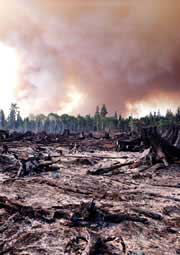COLD safer than HOT

Fires can devastate HOT forests. <br>© Getty Images <br>
New theory shows that high performance needn’t mean high risk.
For man-made systems such as machines and markets, catastrophe lurks somewhere between high risk and high performance. US physicists may have found a way to strike the optimal balance1.
This trade-off is familiar to the financial world. Brokers develop investment portfolios to provide the best returns within a specified level of risk. Mark Newman and co-workers at the Santa Fe Institute in New Mexico have borrowed some ideas from the economic theories of risk aversion to create a general prescription for avoiding ruin.
As a simple model of a system where productivity is coupled to risk, the researchers considered forest management. A forester wants to plant trees densely enough to produce a high timber yield. But the denser the trees, the more susceptible a forest is to devastating fires. So forests include open spaces to limit fires.
In 1999, researchers showed that complex systems like this often have states of ’highly optimized tolerance’ or HOT2,3. In a HOT state, performance (tree yield, in this case) is as good as it can be, in the face of influences (such as forest fires) that potentially undermine it.
But a HOT system has an Achilles’ heel. It is typically fragile under perturbations for which it was not designed. For example, if the distribution of fire breaks or sparks alters slightly, a forest can become highly susceptible to fires and give a poor yield.
Newman’s team now points out that HOT designs have another drawback. The cost of an optimal performance is a high chance of a ruinous collapse. Catastrophic fires that burn nearly all the trees are rare, but not as rare as one would expect if fire size were random. The optimal state is a high-risk state: it gives good returns at the price of possible ruin.
Most engineers don’t want to run this risk. So Newman’s group has calculated how to design a system to optimize performance and almost eliminate the probability of ruinous events. They call this design principle ’constrained optimization with limited deviations’, or COLD.
Surprisingly, a COLD state can completely remove the danger of total ruin while sacrificing only a few per cent of the average yield relative to a HOT state. Newman and colleagues say that, as we are generally risk-averse, we are more likely to prefer COLD designs than HOT ones.
Nature, apparently, is more short-sighted. Ecosystems, for example, are often in HOT states They are catastrophically susceptible to rare disturbances not accounted for by natural selection – such as meteorite impacts.
References
- Newman, M. E. J., Girvan, M. & Farmer, J. D. Optimal design, robustness, and risk aversion. Preprint, (2002).
- Carlson, J. M. & Doyle, J. Highly optimized tolerance: a mechanism for power laws in designed systems. Physical Review E, 60, 1412 – 1427, (1999).
- Carlson, J. M. & Doyle, J. Highly optimized tolerance: robustness and design in complex systems. Physical Review Letters, 84, 2529 – 2532, (2000).
Media Contact
More Information:
http://www.nature.com/nsu/020225/020225-3.htmlAll latest news from the category: Physics and Astronomy
This area deals with the fundamental laws and building blocks of nature and how they interact, the properties and the behavior of matter, and research into space and time and their structures.
innovations-report provides in-depth reports and articles on subjects such as astrophysics, laser technologies, nuclear, quantum, particle and solid-state physics, nanotechnologies, planetary research and findings (Mars, Venus) and developments related to the Hubble Telescope.
Newest articles

A universal framework for spatial biology
SpatialData is a freely accessible tool to unify and integrate data from different omics technologies accounting for spatial information, which can provide holistic insights into health and disease. Biological processes…

How complex biological processes arise
A $20 million grant from the U.S. National Science Foundation (NSF) will support the establishment and operation of the National Synthesis Center for Emergence in the Molecular and Cellular Sciences (NCEMS) at…

Airborne single-photon lidar system achieves high-resolution 3D imaging
Compact, low-power system opens doors for photon-efficient drone and satellite-based environmental monitoring and mapping. Researchers have developed a compact and lightweight single-photon airborne lidar system that can acquire high-resolution 3D…





















